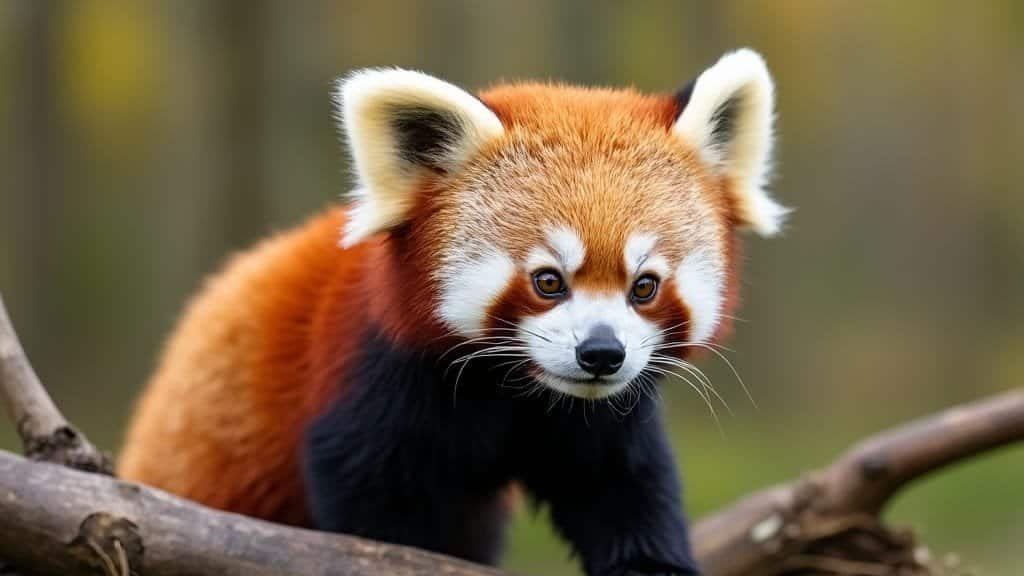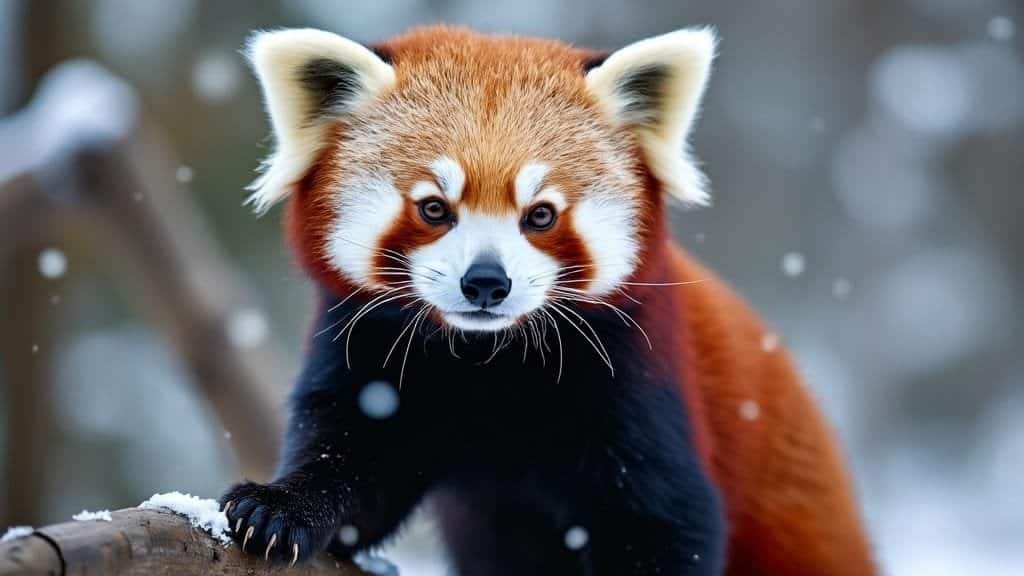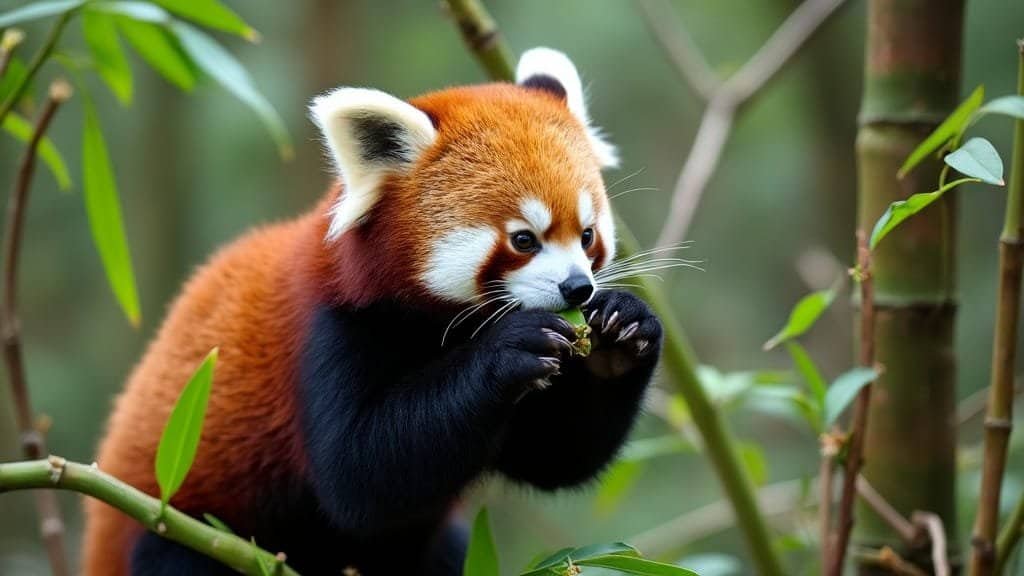Red pandas are continuous feeders, spending up to 13 hours per day eating due to the low nutritional value of bamboo. Unlike other mammals that consume high-energy meals in short periods, red pandas must eat frequently throughout the day to compensate for bamboo’s low digestibility and energy content (San Diego Zoo)
Their feeding cycle follows a cyclic pattern, with multiple small meals spread from morning to night. As crepuscular animals, they are most active at dawn and dusk, alternating between feeding and resting. Bamboo, which makes up 85-95% of their diet, passes through their digestive system quickly, requiring them to refuel often (Red Panda Network)
Seasonal changes also affect their feeding habits—bamboo shoots in spring provide more nutrients, reducing feeding time, while mature leaves in winter force them to eat more frequently to compensate for lower protein levels (San Diego Zoo Global Library). This article explores how often red pandas eat, their feeding schedule, and the seasonal changes in their diet. It also examines how their metabolism and digestion impact feeding frequency and compares wild vs. captive feeding behaviors
Feeding Frequency and Daily Eating Habits

Red pandas have a unique feeding schedule that reflects their low digestive efficiency and dependence on bamboo. Unlike carnivores, which can consume high-energy meals in one sitting, red pandas must eat frequently throughout the day to compensate for bamboo’s poor nutrient content. Their feeding patterns, metabolic needs, and digestion speed all influence how often they must eat to sustain their energy levels
Hours Spent Eating Per Day
Red pandas spend between 8 and 13 hours per day eating, depending on the season, bamboo quality, and environmental conditions. In warmer months, they consume nutrient-rich bamboo shoots, allowing them to digest food more efficiently and spend slightly less time feeding. However, in winter, when only mature leaves and stems are available, their feeding time increases to compensate for the lower protein content of their food
A study by Wei et al. (Journal of Mammalogy, 2014) found that red pandas adjust their feeding time based on food availability, increasing their daily food intake by up to 20% in colder months. This adjustment helps them survive despite the nutritional decline in bamboo during winter
Cyclic Feeding Patterns and Meal Intervals
Instead of eating large meals at fixed times, red pandas consume small amounts of food continuously throughout the day. They follow a cyclic feeding pattern, alternating between feeding sessions and rest periods to balance nutrient intake with digestion
Their schedule includes:
Early morning feeding (dawn): Their first major feeding period, taking advantage of cooler temperatures and low competition for food
Midday rest and digestion: After several hours of eating, red pandas typically rest in trees or shaded areas to conserve energy
Afternoon and evening feeding (dusk and early night): Their second major feeding period, often lasting until late evening, ensuring they consume enough food to sustain them overnight
Red pandas are crepuscular, meaning they are most active at dawn and dusk. This behavior allows them to avoid extreme daytime temperatures while maximizing feeding time when bamboo is more hydrated and easier to digest (San Diego Zoo Global Library)
Metabolic Needs and the Impact on Feeding Frequency
Since bamboo provides low-calorie energy, red pandas have evolved a slow metabolism to help them survive on a fiber-rich but nutrient-poor diet. However, this metabolic adjustment does not eliminate the need for constant feeding. Instead, red pandas must consume food frequently to ensure a steady supply of energy
Because their digestive system cannot store nutrients efficiently, red pandas eat every few hours, spreading their food intake across multiple feeding sessions per day. Unlike some herbivores, which can digest cellulose through fermentation over long periods, red pandas lack the specialized gut bacteria needed for efficient fiber digestion. As a result, bamboo passes through their system in just five hours, requiring them to refuel frequently (Red Panda Network)
For more insights into red panda feeding habits, visit the San Diego Zoo’s article on red panda diets
Seasonal Changes in Feeding Behavior

Red pandas do not eat the same way year-round. Their feeding behavior shifts seasonally due to changes in bamboo availability, temperature, and metabolic needs. These adjustments allow them to maximize nutrient intake when food is abundant and conserve energy when bamboo is less nutritious
Dietary Shifts from Spring to Winter
Throughout the year, red pandas adjust their diet to different parts of the bamboo plant, selecting the most nutritious and digestible food sources available. During spring and early summer, they prioritize bamboo shoots, which are higher in protein and water, making them easier to digest. Because of this, they may spend slightly less time feeding, as each meal provides more energy
By late summer and fall, bamboo shoots become scarce, and red pandas switch to young leaves, which contain moderate fiber and protein but are less hydrating. At this stage, their feeding time begins to increase, as they must eat larger quantities to compensate for the lower nutritional content of their food
Winter presents the greatest challenge, as red pandas are forced to eat mature leaves and stems, which are low in protein and difficult to digest. The high fiber content of these parts slows digestion, forcing red pandas to increase their feeding frequency and duration to extract enough nutrients. A study by Squires et al. (Frontiers in Zoology, 2021) found that red pandas increase their daily food intake by up to 20% in colder months, ensuring they consume enough bamboo to sustain their energy needs
Increased Feeding Time During Low-Nutrient Periods
When bamboo quality declines in late fall and winter, red pandas compensate by spending more time foraging and feeding. Unlike in spring and summer, when food is easier to digest, winter bamboo requires more chewing, more frequent feeding sessions, and longer digestion times
Observations of wild red pandas (San Diego Zoo Global Library) show that they increase their time spent feeding by as much as two additional hours per day in winter. This is necessary to make up for the energy deficit caused by the lower protein and water content of mature bamboo leaves
Because of the extra time required for feeding, red pandas reduce other activities, such as exploring or marking territory, to conserve energy. Their behavior becomes more sedentary, and they spend longer resting between feeding sessions
Energy Conservation Strategies in Colder Months
During winter, red pandas do not hibernate, but they lower their metabolic rate to help them survive on lower-quality food. This adaptation allows them to reduce calorie expenditure, balancing out the fact that they must eat more frequently to maintain their weight
In particularly harsh conditions, red pandas minimize movement to avoid unnecessary energy loss. They spend more time curled up in tree hollows or dense vegetation, reducing exposure to cold temperatures while still foraging when necessary. This energy-conserving strategy is essential for survival, as bamboo alone does not provide sufficient fat or protein reserves to sustain them through an entire winter without feeding
For more insights into seasonal feeding adaptations, visit the Red Panda Network article on diet changes
Digestive Efficiency and Feeding Adaptations

Red pandas have a unique digestive system that influences how often they eat. Unlike herbivores that can efficiently break down fiber, red pandas have a digestive tract similar to carnivores, making it difficult for them to extract nutrients from bamboo. Because of this low digestive efficiency, they must eat frequently and in large quantities to sustain their energy needs
The Fast Digestion Process of Bamboo
One of the primary reasons red pandas eat so often is their rapid digestion time. While herbivores like cows and deer take over 48 hours to fully process plant material, red pandas digest bamboo in as little as five hours. This quick food passage means that nutrients are not fully extracted, forcing them to continuously replenish their energy supply by eating multiple times per day
A study by Wei et al. (Journal of Mammalogy, 2014) found that red pandas absorb only about 24% of the available energy in bamboo, compared to 50-60% in true herbivores. This low nutrient absorption rate explains why they need to consume up to 4.4 pounds (2 kg) of bamboo daily to meet their caloric requirements
Balancing Feeding with Rest Periods
Because eating is so energy-intensive, red pandas must balance feeding with resting to avoid unnecessary calorie expenditure. Unlike highly active animals that travel long distances to forage, red pandas use energy-saving behaviors to maximize their nutrient intake
After a feeding session, they typically rest in tree branches or dense foliage, digesting food before their next meal. This resting period allows them to conserve heat in winter and avoid overheating in summer
Observations from the San Diego Zoo Global Library show that red pandas will often position themselves near reliable bamboo sources, reducing the need for long-distance movement that could drain their limited energy. By alternating frequent meals with rest, red pandas can sustain themselves despite their inefficient digestion and low-energy diet
Differences Between Wild and Captive Red Panda Diets
In the wild, red pandas spend more time feeding because they rely on nutrient-poor bamboo. However, captive red pandas receive nutrient-enriched diets, allowing them to eat less frequently while still meeting their energy needs
Zoos supplement their diet with fruits, leaf-eater biscuits, and even protein sources like eggs or mealworms, which provide more digestible nutrients than bamboo alone. A study from San Diego Zoo Global found that captive red pandas spend less time foraging than their wild counterparts, as their food is nutrient-dense and readily available
Despite this, zookeepers still encourage natural feeding behaviors by spreading food across enclosures, mimicking the frequent foraging habits of wild red pandas. This practice helps captive red pandas maintain their instinctual feeding patterns while ensuring they receive a balanced and sustainable diet
For more insights into how digestion impacts feeding frequency, visit the San Diego Zoo’s article on red panda diets













